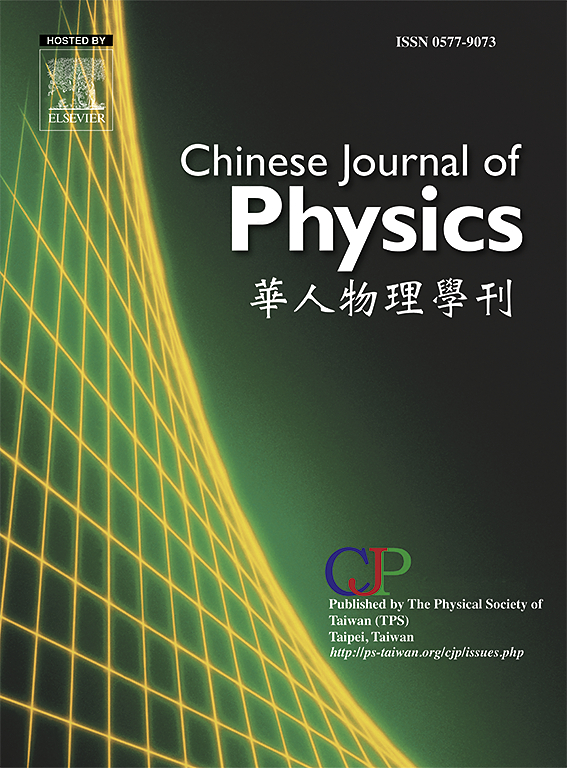Influence of three parameters on decoupled charged compact stars generated by dark matter and their predicted radii in f(R,T) gravity theory
IF 4.6
2区 物理与天体物理
Q1 PHYSICS, MULTIDISCIPLINARY
引用次数: 0
Abstract
In the context of gravity theory we have obtained an exact non-singular solution to the field equations for the anisotropic charged stellar system. The method of minimal geometrical deformation (MGD) with regard to the gravitational decoupling approach is employed to reduce the field equations into two sets of equations governed by the seed system and the new source system. An isotropic charged fluid configuration with modified Durgapal–Fuloria potential as a metric ansatz is considered for the seed system whereas density profile of Pseudo-Isothermal dark matter (PI-DM) is taken into account to mimic a component of the new source system. The anisotropy feature that essentially arises in the effective system is one of the important consequences of the gravitational decoupling approach. With this approach we get the solution to gravitationally decoupled field equations which describes the physical characteristics of an effective anisotropic and charged system. The effective system is found to be stable with regard to Herrera’s cracking concept, adiabatic condition, and Harrison–Zeldovich–Novikov criteria. The influence of the MGD parameter, coupling constant, and dark matter density parameter on the physical features and stability of the effective system have been analyzed and shown graphically. The mass–radius relation of the effective system is inspected in connection to the observational constraint of the massive stars such as pulsars and massive secondary companions involved in gravitational wave events. The maximum mass of the star is apparently constrained with the increasing values of the -gravity coupling constant, MGD parameter, DM density parameter, and charge. Enabling all the set of parameters the range of predicted radii of the observed massive stars was found to be 9.77 km–12.00 km.
f(R,T)引力理论中三个参数对暗物质产生的解耦带电致密星及其预测半径的影响
在f(R,T)引力理论的背景下,我们得到了各向异性带电恒星系统场方程的精确非奇异解。采用最小几何变形(MGD)方法结合引力解耦方法,将场方程简化为种子系统和新源系统控制的两组方程。采用改进的Durgapal-Fuloria势的各向同性带电流体配置作为种子系统的度量,同时考虑伪等温暗物质(PI-DM)的密度分布来模拟新源系统的一个组成部分。有效系统本质上产生的各向异性特征是引力解耦方法的重要结果之一。利用这种方法,我们得到了描述有效各向异性带电系统物理特性的引力解耦场方程的解。根据Herrera的裂化概念、绝热条件和harrison - zelovich - novikov判据,发现有效体系是稳定的。分析了MGD参数、耦合常数和暗物质密度参数对有效体系物理特性和稳定性的影响,并用图形表示。结合引力波事件中脉冲星和伴星等大质量恒星的观测约束,考察了有效系统的质量半径关系。恒星的最大质量明显受到f(R,T)-重力耦合常数、MGD参数、DM密度参数和电荷的增大的约束。启用所有参数集后,观测到的大质量恒星的预测半径范围为9.77 km - 12.00 km。
本文章由计算机程序翻译,如有差异,请以英文原文为准。
求助全文
约1分钟内获得全文
求助全文
来源期刊

Chinese Journal of Physics
物理-物理:综合
CiteScore
8.50
自引率
10.00%
发文量
361
审稿时长
44 days
期刊介绍:
The Chinese Journal of Physics publishes important advances in various branches in physics, including statistical and biophysical physics, condensed matter physics, atomic/molecular physics, optics, particle physics and nuclear physics.
The editors welcome manuscripts on:
-General Physics: Statistical and Quantum Mechanics, etc.-
Gravitation and Astrophysics-
Elementary Particles and Fields-
Nuclear Physics-
Atomic, Molecular, and Optical Physics-
Quantum Information and Quantum Computation-
Fluid Dynamics, Nonlinear Dynamics, Chaos, and Complex Networks-
Plasma and Beam Physics-
Condensed Matter: Structure, etc.-
Condensed Matter: Electronic Properties, etc.-
Polymer, Soft Matter, Biological, and Interdisciplinary Physics.
CJP publishes regular research papers, feature articles and review papers.
 求助内容:
求助内容: 应助结果提醒方式:
应助结果提醒方式:


